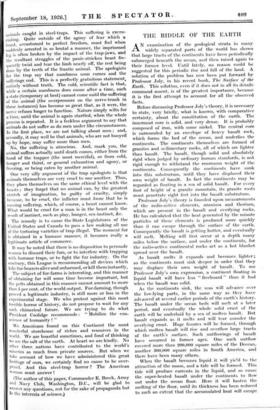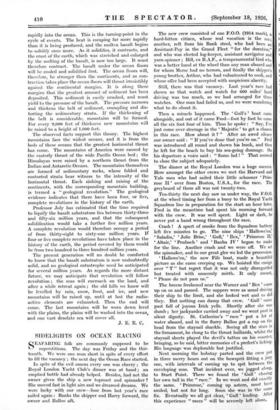THE RIDDLE OF THE EARTH
AN examination of the geological strata in many widely separated parts of the world has shown that large tracts of the continents have been periodically submerged beneath the ocean, and then raised again to their former level. Until lately, no reason could be suggested for this periodic rise and fall of the land. A solution of the problem has now been put forward by Professor Joly, in his recent book, The Surface of the Earth. This solution, even if it does not in all its details command assent, is of the greatest importance, because it is the first attempt to account for all the observed facts.
Before discussing Professor Joly's theory, it is necessary to state, very briefly, what is known, with comparative certainty, about the constitution of the earth. The innermost core is solid, and very dense.• It is probably composed of iron, with sonic nickel. The central core is surrounded' by an envelope of heavy basalt rock, which forms the bed of the ocean, and underlies the continents. The continents themselves are formed of granites and sedimentary rocks, all of which are lighter than basalt. The basalt, though solid and absolutely rigid when judged by ordinary human standards, is not rigid enough to withstand the enormous weight of the continents. Consequently the continents have sunk into this substratum, until they have displaced their own weight of basalt. In fact the continents may be regarded as floating in a sea of solid basalt. For every foot of height of a granite mountain, its granite roots must penetrate eight feet into the basalt substratum.
Professor Joly's theory is founded upon measurements of the radio-active elements, uranium and thorium, which are present in the basalt and overlying rocks. He has calculated that the heat generated by the minute particles of these elements is produced more quickly than it can escape through the surface of the earth. Consequently the basalt is getting hotter, and eventually will melt. Melting will first occur 'at a depth many miles below the surface, and under the continents, for the radio-active continental rocks act as a hot blanket spread over the basalt.
As basalt melts it expands and becomes lighter ; so the continents must sink deeper in order that they may displace their own weight of basalt. To use Professor Joly's own expression, a continent floating in liquid basalt will have less " freeboard " than it had when the basalt was solid.
As the continents sink, the seas will advance over the low-lying parts, in the same way as they have advanced at several earlier periods of the earth's history: The basalt under the ocean beds will melt at a later period, and eventually the whole solid crust of the earth will be underlaid by a sea of molten basalt. But basalt expands as it melts and will tear asunder the overlying crust. Huge fissures will be formed, through which molten basalt will rise and overflow large tracts of the earth's surface. Such outflowings of basalt have occurred in former ages. One such outflow covered more than 200,000 square miles of the Deccan, another 300,000 square miles in South America, and there have been many others.
When the basalt becomes liquid it will yiel_d to the attraction of the moon, and a tide will be formed. This tide will produce currents. in the liquid, and so cause the super-heated basalt under the continents to flow out under the ocean floor. Here it will hasten the melting of the floor, until its thickness has been reduced to such an extent that the accumulated heat will escape rapidly into the ocean. This is the turning-point in the cycle of events. The heat is escaping far more rapidly than it is being produced, and the molten basalt begins to solidify once more. As it solidifies, it contracts, and the crust of the earth, which was stretched and enlarged by the melting of the basalt, is now too large. It must therefore contract. The basalt under the ocean floors will be cooled and solidified first. The ocean floors will, therefore, be stronger than the continents, and as con- traction takes place the ocean floors will thrust irresistibly against the continental margins. It is along these margins that the greatest amount of sediment has been deposited. This sediment is easily crushed, and must yield to the pressure of the basalt. The pressure narrows and thickens the belt of sediment, crumpling and dis- torting the sedimentary strata. If the thickening of the belt is considerable, mountains will be formed. For every 9,000 feet of thickness new mountains will be raised to a height of 1,000 feet. The observed facts support this theory. The highest mountains face the widest oceans, and it is from the beds of these oceans that the greatest horizontal thrust has come. The mountains of America were caused by the easterly thrust of the wide Pacific Ocean bed ; the Himalayas were raised by a northern thrust from the Indian and Antarctic Oceans. The mountains themselves are formed of sedimentary rocks, whose folded and contorted strata bear witness to the intensity of the horizontal thrust. Each sinking and raising of the continents, with the corresponding mountain building, is termed a " geological revolution." The geological evidence indicates that there have been four, or five, complete revolutions in the history of the earth. Professor Joly has estimated that the time required to liquify the basalt substratum lies between thirty-three and fifty-six million years, and that the subsequent solidification would take a further five million years. A complete revolution would therefore occupy a period of from thirty-eight to sixty-one million years. If four or five complete revolutions have taken place in the history of the earth, the period covered by them would be from two hundred to three hundred million years.
The present generation will no doubt be comforted to know that the basalt substratum is now undoubtedly solid, and no geological catastrophe need be anticipated for several million years. As regards the more distant future, we may anticipate that revolution will follow revolution ; the seas will encroach on the land, and after a while retreat again ; the old hills we know will be levelled by rain, snow, frost, and ice, and new mountains will be raised up, until at last the radio- active elements are exhausted. Then the end will come. The last mountains will be worn down level with the plains, the plains will be washed into the ocean, and one vast desolate sea will cover all.
J. E. E. C.































































 Previous page
Previous page